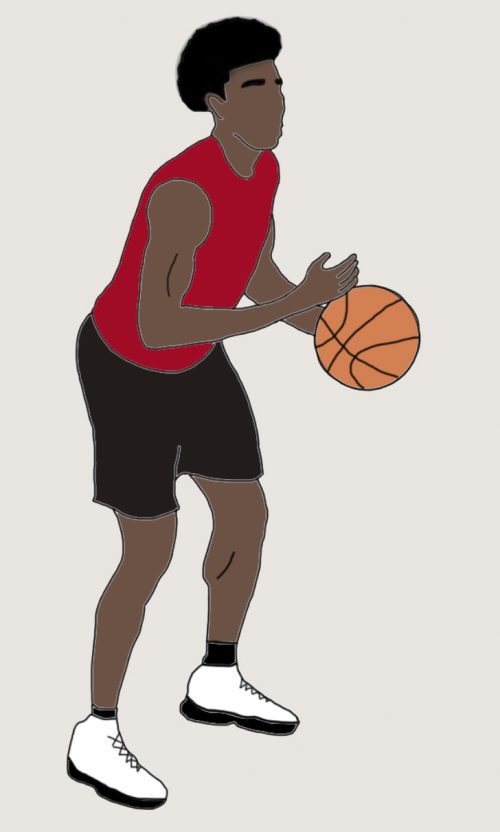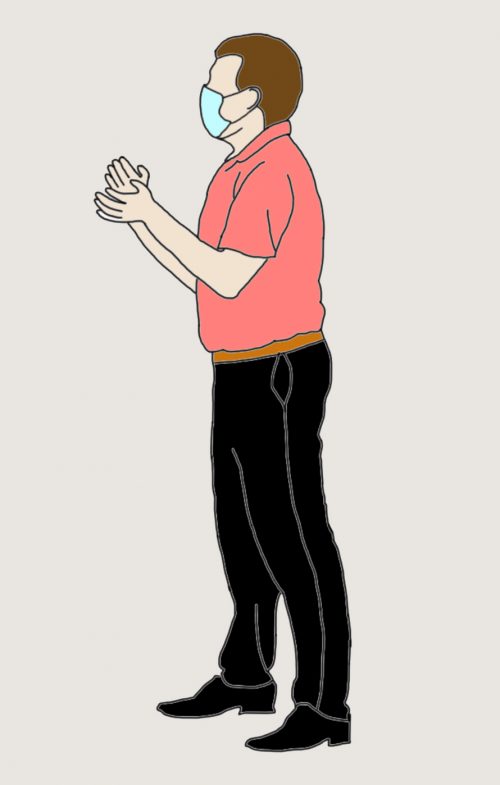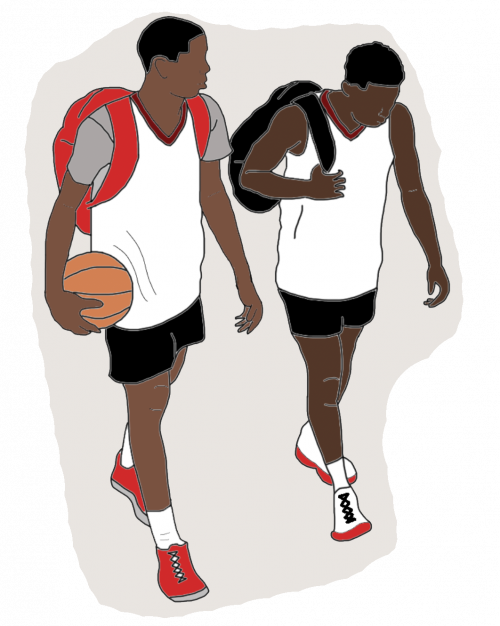Youth basketball clubs find ways to play on in the face of COVID
Written and illustrated by Daniel Ziolkowski
Not one athlete, coach or parent knew what awaited them when they walked into a gym for a basketball tournament over the summer. But the rapid growth of the club basketball scene throughout Wisconsin and the increased presence of college coaches at those events meant most were willing to take the risk — even in the middle of a pandemic.
Those who played say some tournaments went above and beyond to assure the safety of the players and their parents, intent on creating a safe environment for kids to win back a sense of normalcy. Others ignored or barely enforced mask mandates and social distancing protocols.
I attended a high school fall league event at the Center Court Sports Complex in Waukesha in suburban Milwaukee, which also hosted club tournaments throughout the summer. While there were temperature checks at the door and signs that asked people to wear their masks, no one stepped in to enforce those rules. Players walked around freely without masks and sat together to watch games, and there was no limit to the number of fans coming in through the single entry point of the facility.

Yet parents came in droves to watch their sons and daughters play in fall leagues, which essentially offer a preseason for high school programs. The demand for competition is even higher in the summer for Amateur Athletic Union events, when the NCAA allotts multiple time periods for college coaches to actively recruit high school athletes.
“There’s definitely more options, more programs, and I think that it’s gotten to a point where the culture is getting established here in Wisconsin. If you want to play basketball and you want to be serious, to get that college level or further, it’s something you have to do,” Jason Coker says, president of the Evolution Basketball program and head coach of the girls’ varsity team at St. Joseph’s High School in Kenosha. “We’ve sent several kids that had never gained interest through their high school program, but did through us, that are playing in college.”
But in 2020, the summer season was in jeopardy from the moment the Wisconsin Interscholastic Athletic Association shut down high school season in mid-March due to the coronavirus. The threat of losing the opportunity to show off their skills in front of more schools meant these players might never get the attention they deserve, so many took that time to prepare.

Erica Cook is the program director of Wisconsin RAP, which operates primarily out of New Berlin and fields teams from the Milwaukee area. Instead of having open gyms running five-on-five games, Cook and the coaches sent out videos of driveway drills. Players won rewards in the form of merchandise for becoming “video champions.”
Soon, the club expanded to holding team practices at local parks and in the yards of players who had outdoor courts at home so they could stay outside. Coker and his Evolution squad were the primary users of a Kenosha gym for much of the summer.
Jasin Sinani, a senior at Oak Creek High School who played for RAP this summer, started playing club basketball in sixth grade. His goal from day one was to play Division I college basketball. Following a strong junior season, Sinani gained some interest from NCAA Division II and III programs, but knew he needed a big summer if he wanted to hear from bigger schools. On top of all the program’s drills, Sinani worked out with a private trainer and played on the half court in his backyard.
“During quarantine I changed my focus onto working out, whether that was in the weight room or on the court. I’m lucky enough to have a little set up in my basement with the weights and a little under a half-court in my backyard,” Sinani says. “This [final] year is the biggest people have in their years playing AAU.”
But practices and drills don’t earn scholarship offers if no one can see what they’ve developed. So after roughly two months of deliberation, programs emailed parents to gauge their comfort level with starting a season. Of the 130 responses to RAP’s parent survey, over 80% wanted to “move forward with some sort of season.” Evolution saw similar results within their program.
“We had our team set right before this COVID thing hit … I’d say we lost maybe 10% to 15% of our players on our teams because they just didn’t want to come back with COVID. Everyone else was like, ‘Man, let’s go, let’s play.’” Coker says.
Some other clubs saw similar reactions. Matt Bredesen is a head coach for teams from ages 15-17 for the the Wisconsin Swing of Waunakee, as well as a teacher and boys’ varsity coach at Janesville Parker High School. Swing didn’t officially sponsor teams, but they didn’t have a hard time filling out their rosters and “got everyone” they wanted at their tryouts for next year.

“What we ended up doing for the teams who wanted to keep playing, which was 10 of the 11 high school teams, was getting our own insurance and covering it,” Bredesen says. The coach also noted the importance of basketball for a lot of the kids goes beyond earning scholarships to their mental and physical health.
A nationwide survey conducted over quarantine by UW Health and the University of Wisconsin School of Medicine and Public Health showed a 37% increase in student athletes who reported “feelings of anxiety and depression at levels that would normally require medical intervention,” and found that physical activity levels were down 50% from before the pandemic.
When tournaments finally started around Independence Day, coaches met a dizzying amount of paperwork and inconsistency. Especially before a state mask mandate which took effect on Aug. 1, sports complexes were largely on their own to determine the best way to curb the spread of coronavirus. They had Anthony Fauci’s guidance and a baseline document from the high school athletic association outlining safe practices to follow, but nothing was necessarily required beyond masks.
Those who attended tournaments over the summer say some organizers were willing and able to enforce strict protocols to keep everyone safe — procedures included clearing and sanitizing entire gyms, requiring masks and temperature checks and limiting numbers of guests. Many only allowed one parent to attend. Some didn’t allow even that. In other cases, complexes asked for a flat-rate payment for 10 spectators, even if there were only four coming. Both Cook and Coker referred to the constant cycle of paying and getting refunds for canceled tournaments as a “nightmare,” but also necessary.
Other facilities remained oblivious to what was happening around them.
“There was one that didn’t have any restrictions, and I lost seven or eight players [who left] after that weekend because they didn’t have anything in place, it was like the wild, Wild West, and they didn’t even charge for people to come in,” Coker says. The coach also believed there may have been some teams and coaches “guilty of kind of sweeping it under the rug.”
In the Wisconsin Dells area, JustAgame Fieldhouse was linked to an outbreak of at least 22 athletes, according to reporting by WISC-TV. The fieldhouse told WISC it had since added a mask requirement for people in the building except for those participating gin the game
Where restrictions were well maintained, however, athletes say amateur clubs were successful in accomplishing their main goal of getting players to college. Sinani received heavy Division I interest by the end of the summer, after performing especially well against a team featuring four players in 247Sports’ Top 100 recruits in the Class of 2021. He is now committed to UW–Milwaukee on a full basketball scholarship.

“Without AAU, to be honest, I don’t know if I would’ve received any Division I interest until the midway or end of my high school season, which is pretty late in the recruiting process,” Sinani says. “I don’t know if things would’ve worked out.”
Now all attention turns to the high school season, which started in mid-November. The governor of Illinois, J.B. Pritzker, announced the state would upgrade basketball to a “high risk” sport on Oct. 27, postponing the season. In Wisconsin, the Badger Conference in Dane County has already announced it will not host winter sports through the fall semester, which ends Jan. 22.
On Sept. 1, the Wisconsin Interscholastic Athletic Association issued an extensive document advising athletic administrators how to safely operate athletic events for fall sports that largely aligns with what teams have considered safe. One thing that stands out, however, is a statement that says athletes should wear masks while practicing or playing indoors, which impacts winter sports more than fall sports. Cook doesn’t fully agree with the precaution, preferring rules that require players wear masks while entering and exiting facilities but not while they play, but trusts whatever the association decides.
If the season is postponed or canceled, one big question remains: Will club programs decide to let high school level teams play on through the winter to fill the void?
The programs’ representatives were adamant they prefer to see the high school season move forward because of how many more kids are involved — roughly 540,000 boys and girls participated across the U.S. in the 2018 season — but didn’t leave anything off the table. But a winter club season may also be a possibility. Cook has had RAP ready to go through winter for weeks now.
“I support the high school season. And I think it’s really great for tradition and for kids,” Cook says. “But if for some reason the WIAA shut it down, and we’ve told our club members this too, we would step in and provide something for kids that was safe.”